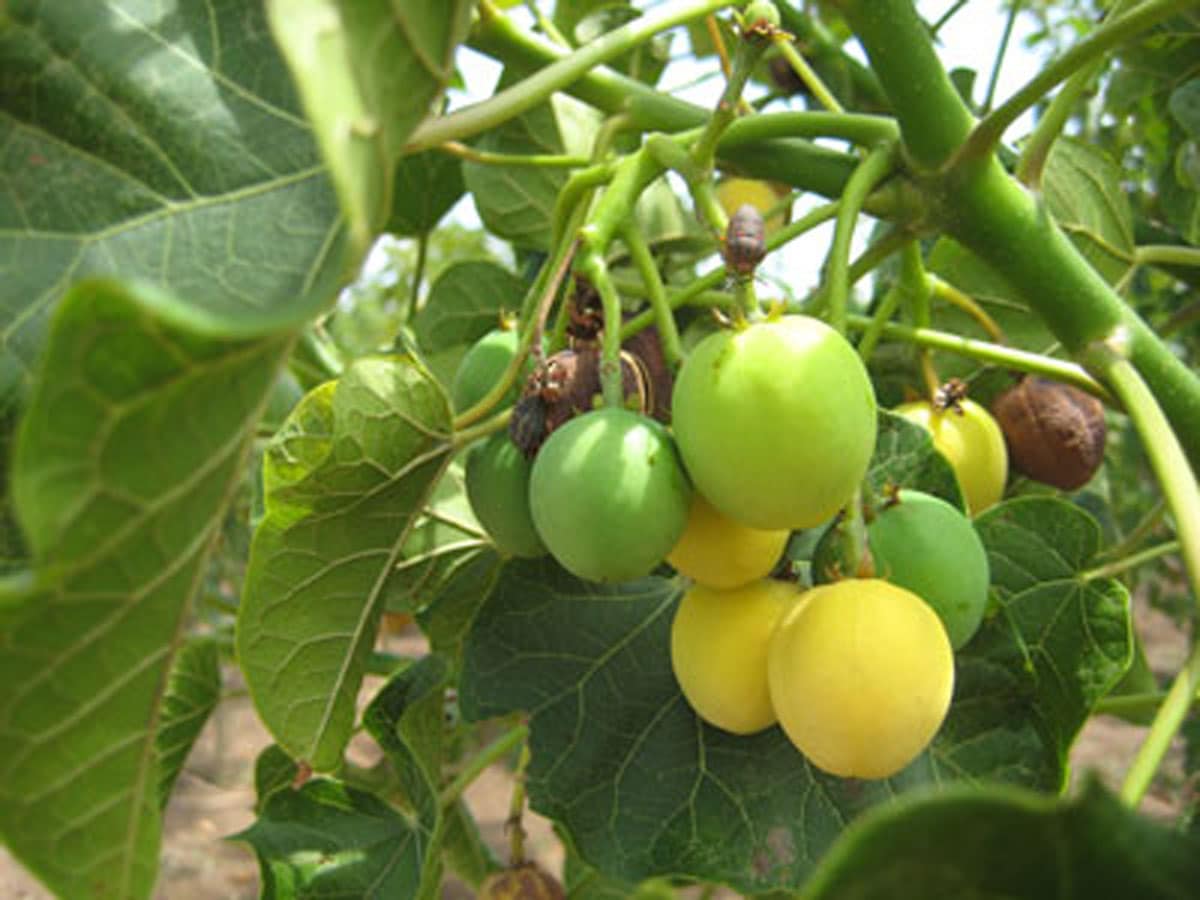Reached this article by mistake? Click here to access the pearl millet article.
Only a few short years ago many on Wall Street were convinced that the jatropha plant was destined to become the next breakthrough biofuel crop. Jatropha grows fast and quickly bears nuts rich in oil content, 35% oil by some estimates. It tolerates poor soils and seems to be fairly drought-resistant even though it\’s native to the tropics. However, investors could never get the economics to work. By 2014 a state-led effort to foster a jatropha-based biodiesel industry in Ghana went bust, and today most jatropha dreams have been put on the back burner.
In Haiti, however, scientists see real potential to produce food and feed as well as revegetate deforested hillsides boost smallholder farm income. Haitian scientists concur that the economics of jatropha biodiesel don’t pencil out, but they see real potential in jatropha for making higher-valued cooking oils, spreads, and animal feed. There’s just one problem, as laid bare in a 2010 report by the U.N. Food & Agriculture Organization: “Jatropha’s chief weaknesses relate to the fact that it is an essentially wild plant that has undergone little crop improvement.” (http://www.fao.org/3/i1219e/i1219e.pdf)
Most species of jatropha are native to the Western Hemisphere, especially Central America and parts of Mexico. Indigenous peoples have been utilizing this plant for centuries, using its beans to make dyes and other materials. They even figured out a way to eat jatropha beans, even though most jatropha species are poisonous. Roasting them can remove toxicity, but edible, non-toxic varieties have been identified and cultivated for some time, and it is these edible kinds of jatropha that interest Gael Pressoir, Dean of the Faculty of Agricultural and Environmental Sciences at Université Quisqueya in Port-au-Prince, Haiti. “It has potential for aquaculture to make fishmeal-free fish feed,” Pressoir told Grow Further. “If that works, edible jatropha could be a potentially very interesting crop.” He also notes how edible jatropha beans can be processed into cooking oils and even a tasty, spreadable treat nearly indistinguishable from peanut butter. “It makes great ice cream,” he added.
“Edible jatropha could be a potentially very interesting crop.”
“It makes great ice cream.”
The original inhabitants of southern Mexico and Guatemala were certainly familiar with the nutritional and potential medicinal benefits of jatropha. But they never domesticated this plant. As a consequence, production is too inconsistent and still largely determined by the whims of nature. Its nuts may be comprised of 35% oil, but if one jatropha plant yields too few nuts then this is of little benefit. Modern agriculture has thus far failed to tame the (mostly) wild jatropha, as FAO noted, but scientists are working on it. Researchers in Singapore and Brazil have written that the best path forward for jatropha is through plant breeding to produce a usable domesticated variety that is both safe to eat and that yields more oil. The Singaporean group is pursuing genetic mapping of jatropha to find the most efficient way to breed for the most beneficial traits (https://journals.plos.org/plosone/article?id=10.1371/journal.pone.0023632). Meanwhile, a Brazilian team is working out statistical methods for achieving the same goal (https://journals.plos.org/plosone/article?id=10.1371/journal.pone.0247775). Pressoir says he’s busy tinkering with jatropha varieties, too. “We have also developed higher-yielding and more rustic edible varieties,” he confirmed. “For yield [to improve] it will require both good agronomics—intercropping with a nitrogen fixator or fertilization—and good varieties. But yes, it is still for me my most promising crop.”
“It will require both good agronomics—intercropping with a nitrogen fixator or fertilization—and good varieties.”
Revitalizing Haitian agriculture is critical to that nation’s future. A flood of cheap rice imported from the United States beginning in the 1990s crushed Haiti’s farmers. Driven to destitution, thousands of these former smallholder farmers fled to Port-au-Prince, where many of them were later killed in the devastating 2010 earthquake. The main fuel for cooking in Haiti is charcoal, and the countryside has suffered massive deforestation as a consequence. Cities like Gonaïves are surrounded by barren hills of sandy soils that release deadly flash floods during tropical storms. As it turns out, sandy soils are ideal for jatropha, and this plant\’s deep root systems and densely growing structures help prevent soil erosion and downstream flooding. Pressoir dreams of brown, denuded hillsides turning green again with rows upon rows of jatropha plants tended by content and relatively prosperous smallholder farmers, helping to restore some of Haiti’s lost ecological balance and agricultural economy. Such transformation could also return a semblance of food security to Haiti, as the country is far too dependent on food imports and thus vulnerable to disruptions like global food price spikes.
Pressoir said he doesn’t see jatropha competing in the market against oil palm as a biodiesel ingredient anytime soon, but he thinks it will eventually hold its own against the ubiquitous soybean for use in making oils, fats, and animal feed. “It is hard to beat oil palm,” he told us. “My goal would be rather to match soybean.” Further research and experimental plant breeding are in order. Agricultural innovation will be key to jatropha’s smallholder farming success in Haiti or anywhere for that matter. “We had completely replaced soymeal with jatropha meal for poultry. We need to do the same in aquaculture,” Pressoir said. “I would like to set up a small demonstration scale farm and continue research to produce the good edible hybrids that would be commercially viable.”
Dr. Pressoir, we share your excitement and may be helping you do just that in the not-too-distant future.
— Grow Further




